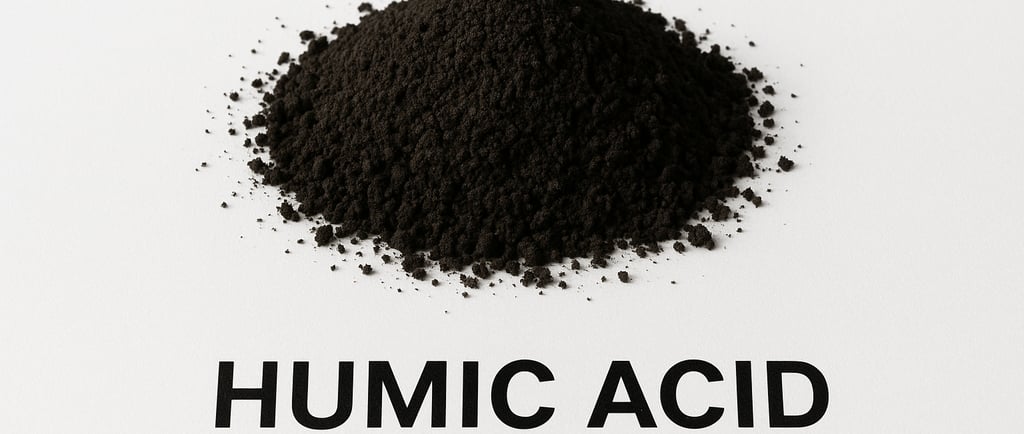"Humic Acid: Turning Ordinary Soil into a Fertility Powerhouse"
Humic acid is a complex natural organic compound that is primarily found in soil as well as peat and coal deposits. Its formation occurs through the decomposition of organic matter, which includes the breakdown of plant and animal residues.
SOIL HEALTH & FERTILITY
8/15/20258 min read


What is Humic Acid?
Humic acid is a complex natural organic compound that is primarily found in soil as well as peat and coal deposits. Its formation occurs through the decomposition of organic matter, which includes the breakdown of plant and animal residues. This process leads to the accumulation of humic substances, where humic acid is a major component. Its presence in soil is vital for maintaining soil health and fertility, making it a crucial element in sustainable agricultural practices.
The chemical properties of humic acid are diverse and contribute significantly to its efficacy as a soil amendment. Humic acid is known for its high cation-exchange capacity, allowing it to retain essential nutrients and release them as needed for plant uptake. Additionally, its ability to improve soil structure facilitates better aeration and water retention, creating an optimal environment for root development. Moreover, humic acid enhances the microbial activity in soil, fostering a robust ecosystem that supports plant growth.
In the context of sustainable agriculture, humic acid plays a pivotal role in enhancing soil health. It helps mitigate soil degradation by improving nutrient availability and promoting microbial diversity, which are imperative for long-term productivity. Farmers and gardeners who incorporate humic acids into their practices often observe increased crop yields and enhanced resilience against environmental stressors. The natural properties of humic acid not only contribute to soil enrichment but also align with eco-friendly agricultural goals, underscoring its significance in cultivating sustainable farming methods.
Applications of Humic Acid
Humic acid has gained recognition for its multifaceted applications in agriculture, horticulture, and gardening. One of the most significant benefits of incorporating humic acid into soil is its ability to enhance nutrient availability. It acts as a natural chelator, binding to essential minerals and trace elements, which facilitates easier uptake by plants. This process not only maximizes nutrient efficiency but also reduces the need for chemical fertilizers, leading to more sustainable gardening practices.
Furthermore, humic acid plays a crucial role in improving soil structure. When added to soil, it enhances the aggregation of soil particles, resulting in better aeration and improved water retention. This is particularly beneficial in sandy or compacted soils, where moisture retention is often a challenge. The improved soil structure ultimately contributes to healthier root development, which is vital for plant growth and productivity.
Moreover, humic acid significantly increases microbial activity in the soil. A thriving population of beneficial microorganisms is essential for nutrient cycling and soil health. These microbes break down organic matter, releasing nutrients that are readily available to plants. The application of humic acid fosters an environment conducive to these beneficial organisms, thus promoting a balanced ecosystem within the soil.
Beyond gardening, humic acid has practical applications in environmental remediation and waste treatment. Its ability to bind to metals and other pollutants makes it an effective agent for cleansing contaminated soil and water. By using humic acid in these contexts, practitioners can facilitate the restoration of environments affected by industrial activities or agricultural runoff.
In summary, the diverse applications of humic acid highlight its importance not only in enhancing garden productivity but also in promoting ecological health and sustainability in various contexts.
Advantages of Using Humic Acid
Incorporating humic acid into gardening practices presents a myriad of benefits that can significantly enhance plant health and soil quality. One of the primary advantages of humic acid is its ability to improve plant growth. It stimulates root development, which leads to a more robust plant structure capable of withstanding environmental stressors. As a result, gardeners often observe an increase in crop yield and overall vigor in their plants, making humic acid a vital component for both home gardens and larger agricultural operations.
Another notable benefit lies in the enhanced nutrient absorption facilitated by humic acid. It acts as a natural chelating agent, allowing essential minerals and nutrients to bind to organic structures in the soil. This process not only makes nutrients more accessible to plants but also improves their efficiency in nutrient uptake. Consequently, plants treated with humic acid can better utilize available resources, optimizing their growth potential.
Moreover, humic acid plays a significant role in preventing soil erosion. Its natural properties promote soil structure and stability, reducing the likelihood of nutrient loss due to water runoff. This is crucial for maintaining healthy garden ecosystems, as good soil structure supports beneficial organisms that contribute to soil health. By incorporating humic acid, gardeners can effectively bolster their soil's resilience against erosion, particularly in areas prone to heavy rainfall.
Lastly, the use of humic acid can significantly lower the need for chemical fertilizers. By improving nutrient bioavailability and fostering a healthy soil ecosystem, it allows gardeners to rely less on synthetic inputs. This shift towards more sustainable practices not only benefits the environment but also cultivates healthier plants and produce. Overall, the advantages of humic acid extend well beyond individual plants, contributing to a healthier and more sustainable gardening approach.
How to Use Humic Acid Effectively
Utilizing humic acid in gardening can significantly improve soil health and plant vitality. However, to reap these benefits, it is crucial to apply it appropriately. Humic acid is available in various forms: liquid, powder, and granules. Each form offers unique application methods, which can cater to different gardening needs.
For liquid humic acid, it is typically diluted with water before application. The recommended dilution rate is usually around 1:100, meaning one part humic acid to 100 parts water. This mixture can be applied directly to the soil or used as a foliar spray, allowing nutrients to be absorbed through the leaves. Powdered and granular forms, on the other hand, can be mixed into the soil prior to planting. A general guideline is to apply 1-2 pounds of humic acid per 100 square feet of garden area. It is essential to follow the manufacturer's instructions on the label to avoid overapplication.
The timing of application is also vital. Humic acid can be applied during the planting phase, but it can also be beneficial throughout the growing season. Typically, applying humic acid once in the spring and again mid-summer encourages healthy growth. Another consideration is that applying humic acid before heavy rainfall or plant watering can enhance its effectiveness, as it helps facilitate nutrient uptake.
Gardeners should also be aware of common mistakes to maximize the use of humic acid. Over-dilution or under-dilution, as well as incorrect application timing, can hinder the desired outcomes. Additionally, it is important to monitor soil nutrient levels; while humic acid enhances nutrient absorption, it does not replace traditional fertilizers. Understanding these factors ensures that gardeners can effectively employ humic acid to promote robust plant growth and soil fertility.
Home Garden Use of Humic Acid
In recent years, the use of humic acid in home gardens has gained popularity among gardening enthusiasts and experts alike. Humic acid, a natural organic compound derived from decomposed plant and animal matter, enhances soil health and promotes plant growth by improving nutrient uptake and stimulating microbial activity. For small-scale gardeners, integrating humic acid into their routine can yield impressive results, transforming average gardens into flourishing green spaces.
One of the most effective ways to utilize humic acid is by mixing it into the soil before planting. For example, vegetables such as tomatoes, peppers, and cucumbers greatly benefit from humic acid treatments, as it enhances nutrient availability and root development. Additionally, it can be particularly advantageous for flowering plants like roses and perennials, which thrive in enriched soil conditions. By amending garden beds with humic acid at the beginning of the growing season, gardeners can set a solid foundation for robust plant health.
In liquid form, humic acid can be applied as a foliar spray or soil drench. A common practice among home gardeners is to create a humic acid solution and use it to water their plants, especially during the critical growth stages. This practice not only aids in nutrient absorption but also helps improve soil structure, facilitating aeration and moisture retention. Anecdotal evidence from avid gardeners supports the notion that their plants develop greener foliage and yield healthier fruit when treated with humic acid.
Furthermore, incorporating humic acid into compost or compost teas can enhance its benefits, as it promotes microbial diversity and activity. This synergistic approach to gardening ensures that soil remains rich in nutrients, contributing to sustainable gardening practices. By understanding how to utilize humic acid effectively, home gardeners can harness its power to create vibrant, thriving gardens.
Success Stories: Real Gardeners Share Their Experiences
Many gardeners have embraced humic acid and have shared transformative experiences that highlight its beneficial effects on soil and plant health. One particularly compelling account comes from Jane, a passionate gardener who struggled with poor soil quality. After applying humic acid to her vegetable garden, she noticed a significant improvement in the soil structure. “The plants are thriving,” she reported. “My tomatoes are bigger and tastier than ever before!” This resonates with the widely recognized potential of humic acid to enhance nutrient absorption and improve soil aeration.
Another gardener, Mark, who runs a small orchard, experienced similar success after integrating humic acid into his fertilization regime. He observed that the overall vitality of his fruit trees had increased substantially. “Since I started using humic acid, my apple yield has doubled,” he stated. By enriching the soil with this organic compound, he enhanced not only the quantity of his harvest but also the quality of the fruits. This aligns with findings that humic acid can improve microbial activity and nutrient availability, fostering a healthier ecosystem for plants.
Furthermore, Rachel, an urban gardener, shared her experience with using humic acid in her container gardens. She emphasized how it helped retain moisture and encouraged faster germination of seeds. “I simply mix it into the potting soil, and the results are astounding,” she noted. The increase in seedling success rates exemplifies humic acid's role in promoting plant growth. Gardeners across various landscapes—from traditional plots to urban settings—are discovering the advantages of this natural soil amendment.
These testimonials reinforce the idea that humic acid can indeed be a powerful ally in gardening. By enhancing soil fertility, improving water retention, and increasing crop yields, real gardeners are witnessing firsthand the remarkable benefits this organic substance can bring to their gardening efforts.
Conclusion: Harnessing Humic Acid for a Thriving Garden
In conclusion, the versatility and benefits of humic acid in gardening cannot be overstated. This natural substance, derived from decomposed organic matter, plays a crucial role in enhancing soil health and promoting plant growth. Its ability to improve nutrient absorption, retain moisture, and stimulate beneficial microbial activity makes it an invaluable asset for any gardener looking to create a thriving garden. By enriching the soil with humic acid, gardeners can significantly increase crop yield, improve plant resilience, and support sustainable gardening practices.
Additionally, humic acid’s role in maintaining soil structure should not be overlooked. The humic compounds aid in developing a crumbly texture that encourages aeration and drainage, thereby nurturing roots and encouraging strong plant development. This improved soil structure not only benefits plants but also contributes to minimizing soil erosion, making it an excellent choice for environmentally conscious gardeners.
Moreover, integrating humic acid into your gardening regimen is a straightforward process. Whether through commercial products or homemade compost enriched with organic material, the incorporation of humic acid can be seamlessly achieved. By actively experimenting with different forms and applications of this powerful compound, gardeners can tailor their approach based on the specific needs of their soil and plants.
We encourage readers to consider the advantages of humic acid and share their experiences in utilizing it within their gardens. This feedback can be invaluable for building a community focused on successful gardening strategies. Embracing humic acid not only supports plant health but also promotes a holistic approach to gardening, harmonizing the relationship between plants, soil, and the environment.


"Boosting Crop Growth With Nature's Power"
Contact Us:
E Mail: support@frosil.com
Customer Care: +91 8329592991
FROSIL © 2025. All rights reserved.


'Frosil' is a fertilizer manufacturer committed to enhancing soil health and crop yields. We provide high-quality, eco-friendly products that support sustainable agriculture and help farmers achieve optimal results.
Registered Office: Gat No.96, Near Krushnai Hospital, Tandali. Tal- Shirur, Dist- Pune.
